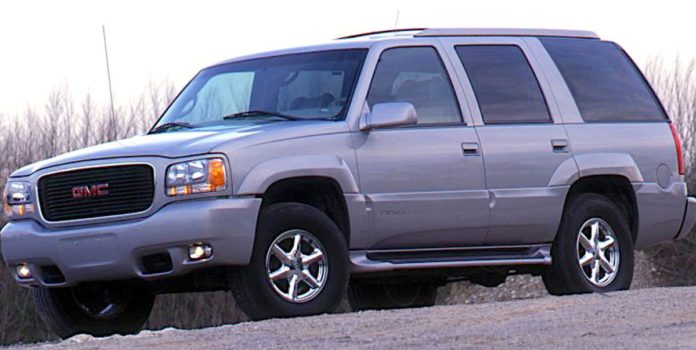From the August 1998 issue of Car and Driver.
Lincoln dressed up an Expedition to create the Navigator, Lexus softened a Land Cruiser to turn out the LX470, and Infiniti gussied up a Pathfinder to make the QX4. Finally, General Motors joins the spruced-up sport-ute crowd with its new GMC Yukon Denali.
The Yukon Denali sprang from the three-door Yukon sport-utility, which in Chevy showrooms is the five-door Tahoe. Among the mainstream big-bruiser utes, the Chevrolet/GMC Suburban is the biggest, followed by the Ford Expedition/Lincoln Navigator twins, after which comes the Tahoe/Yukon/Yukon Denali trio, and finally the Dodge Durango.
The Yukon Denali’s raison d’être is to satisfy the demands of customers who want more features. “Eighty percent of regular Yukons were sold with every available option,” says GMC assistant brand manager for product Kevin Stein. “We needed something for the customers to step up to from the regular Yukon.”
Mechanically, the Yukon Denali is the same as the regular ol’ Yukon. The only engine available is the iron 5.7-liter V-8. This backbone of GM’s trucks pumps out a healthy 255 horsepower at 4600 rpm and 330 pound-feet at 2800 rpm. (Those new LS-1-based V-8s due to appear in the new GM full-size pickup won’t be available in the Yukon until 2000.) A four-speed automatic sends power to GM’s AutoTrac transfer case. The system has four modes—two-wheel drive, full-time four-wheel drive (when wheelspin is detected, torque is automatically transferred to the front axle, but otherwise only the rear wheels are driven), four-wheel-drive high, and four-wheel-drive low.
This engine-and-driveline combination yielded a 0-to-60-mph sprint of 9.7 seconds and a quarter-mile time of 17.4 seconds at 79 mph. The brakes hauled the 5540-pound beast down from 70 mph in 227 feet, and on the skidpad, the Yukon Denali generated 0.72 g of lateral grip. Top speed is governed to 111 mph. Among the other big utes mentioned here, the Yukon Denali is the best on the skidpad and about midpack in the acceleration tests. The Denali’s handling has not rewritten the laws of physics—it feels very large and heavy, and its mushy brake pedal does little to make the driver feel confident.
Cosmetically, this sport-ute is much different from a stock Yukon. GMC did more than add a new grille and body cladding. All the sheetmetal in front of the A-pillar is unique to the Denali, as are the wheels and the exhaust tips. The overall effect is definitely upscale and drew some admiring comments.
The interior gets the full-glitz treatment. The leather-covered front seats are wider and deeper than Yukon seats, which were already some of the flattest seats made. In the heated-seats department, the Denali one-ups the base Yukon by cooking the buns of outboard rear-seat occupants, too. Although there’s no third seat available in the Denali, interior upgrades include a Bose Acoustimass stereo system with a Delco AM/FM/cassette/CD player in the dash and a CD changer in the center console, and genuine Zebrano wood trim pieces—just like Cadillac uses—on the doors and center console.
Besides the color of the paint and interior, buyers have only two choices to make. Side-hinged rear panel doors can be ordered at no extra cost in place of our test car’s window-and-tailgate system, and GM’s OnStar system is available for $1300. (OnStar provides one-touch cellular-phone connection to roadside assistance and numerous concierge services.)
And so we come to the bottom line—the big, fat sticker. A base Denali without OnStar costs $43,495, which is about six grand more than a loaded Yukon. A similarly equipped Navigator costs about two grand more than the Denali, but it includes a third seat and a sunroof. Look for the trend toward upscale utes to continue with a Cadillac version of the Yukon due later this year and a spiced-up Suburban a strong possibility for production.
Specifications
Specifications
1998 GMC Yukon Denali
Vehicle Type: front-engine, rear/4-wheel-drive, 5-passenger, 5-door wagon
PRICE
Base/As Tested: $43,495/$44,795
ENGINE
pushrod 16-valve V-8, iron block and heads, port fuel injection
Displacement: 350 in3, 5733 cm3
Power: 255 hp @ 4600 rpm
Torque: 330 lb-ft @ 2800 rpm
TRANSMISSION
4-speed automatic
DIMENSIONS
Wheelbase: 117.5 in
Length: 201.2 in
Curb Weight: 5540 lb
C/D TEST RESULTS
60 mph: 9.7 sec
1/4-Mile: 17.4 sec @ 79 mph
100 mph: 31.9 sec
Rolling Start, 5–60 mph: 10.2 sec
Top Speed (gov ltd): 111 mph
Braking, 70–0 mph: 227 ft
Roadholding, 300-ft Skidpad: 0.72 g
C/D FUEL ECONOMY
Observed: 13 mpg
EPA FUEL ECONOMY
City: 12 mpg
C/D TESTING EXPLAINED


